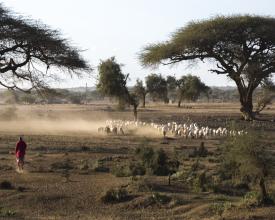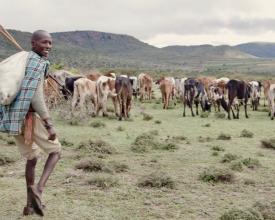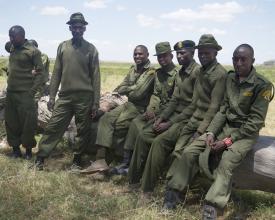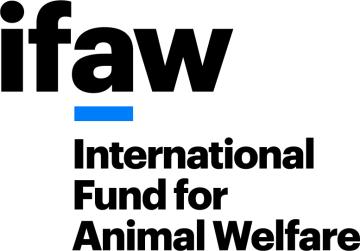
Prosperar juntos: Lograr los Objetivos de Desarrollo Sostenible y aumentar el bienestar de los animales y las personas

El Parque Nacional Amboseli alberga algunas de las mayores poblaciones de elefantes de Kenia. Sin embargo, el parque es pequeño y los elefantes necesitan las tierras comunitarias circundantes para satisfacer sus necesidades. En 2008, las partes interesadas locales reconocieron que la pérdida, degradación y fragmentación del hábitat conduciría a la pérdida de medios de subsistencia e ingresos por turismo y optaron por garantizar la sostenibilidad del ecosistema. Por ello, el IFAW se asoció con las partes interesadas pertinentes para asegurar corredores críticos y zonas de dispersión para los elefantes en áreas comunitarias del paisaje de Amboseli. Para lograrlo, el IFAW asumió el compromiso plurianual de asegurar 26.000 acres como tierras de migración y dispersión de la fauna silvestre en el paisaje de Amboseli.
Contexto
Défis à relever
El Parque Nacional de Amboseli, en el sur de Kenia, alberga la mayor población de elefantes del país (unos 2.000), pero no puede cubrir por sí solo sus necesidades ecológicas. Los elefantes y otros animales salvajes dependen de los 5.700 kilómetros cuadrados de tierras comunitarias maasai de los alrededores para dispersarse y pasan hasta el 80% de su tiempo en estos ranchos comunitarios. En concreto, los elefantes utilizan los ranchos comunitarios como corredores cruciales para migrar a otras zonas protegidas como Tsavo, al norte de Kenia, y el Parque del Kilimanjaro, al sur de Tanzania. Sin embargo, en 2008, los principales interesados y propietarios de la tierra -los ranchos del grupo masái que rodean el Parque- y el gobierno keniata -a través de su paraestatal el Servicio de Vida Silvestre de Kenia (KWS) como custodios del Parque- reconocieron que la amenaza de pérdida, degradación y fragmentación del hábitat provocaría la pérdida de medios de subsistencia y de ingresos procedentes del turismo. Cuestiones todas ellas que el IFAW decidió abordar en este proyecto.
Ubicación
Procesar
Resumen del proceso
La incorporación de las aportaciones de la comunidad de forma estructurada y profunda ha dado lugar a intervenciones únicas adaptadas a esta comunidad específica e intervenciones sostenibles y populares entre la comunidad. Así, el establecimiento del Plan de Gestión del Ecosistema de Amboseli (AEMP) 2008-2018 ha permitido separar las zonas de uso del suelo para la conservación, el pastoreo, la agricultura y los asentamientos, con la esperanza de facilitar la mitigación de los conflictos entre los seres humanos y la fauna salvaje. Al asegurar el corredor de Kitenden, el IFAW está ayudando a establecer una zona de conservación comunitaria que ayuda a proteger, restaurar y promover el uso sostenible del ecosistema de Amboseli, al tiempo que revierte la degradación del suelo y frena la pérdida de biodiversidad. Gracias a la cartografía de los corredores de la fauna salvaje, las zonas de asentamiento y las amenazas potenciales para la fauna, el proyecto ha asegurado 26.000 acres de rutas y corredores migratorios de la fauna salvaje, así como zonas de dispersión en beneficio de la fauna salvaje. Esto no sólo beneficia a la fauna local, sino que también ha permitido el desarrollo sostenible de la comunidad porque también gestiona las zonas de tierra utilizadas para la agricultura, los asentamientos, las instalaciones, entre otros, creando así una oportunidad para que la comunidad desarrolle aún más la capacidad, el crecimiento económico y las oportunidades de trabajo.
Bloques de construcción
Colaboración con el rancho Olgulului Olalarashi Group y KWS
El Parque Nacional de Amboseli alberga algunas de las mayores poblaciones de elefantes de Kenia, que dependen de las tierras comunitarias circundantes para migrar. En 2008, los interesados en las tierras reconocieron que las amenazas de pérdida, degradación y fragmentación del hábitat conducirían a la pérdida de medios de subsistencia e ingresos por turismo y optaron por garantizar la sostenibilidad del ecosistema. Por ello, el IFAW se asoció con las partes interesadas pertinentes para asegurar corredores críticos y zonas de dispersión para los elefantes en áreas comunitarias del paisaje de Amboseli. Para lograrlo, el IFAW asumió el compromiso plurianual de asegurar 26.000 acres como tierras de migración y dispersión de la fauna silvestre en el paisaje de Amboseli (el corredor de Kitenden, uno de los últimos corredores migratorios de elefantes que quedan y que conecta Kenia y Tanzania).
Factores facilitadores
La estrategia para la tierra arrendada fue desarrollar la Kitenden Community Wildlife Conservancy, que seguirá ofreciendo un triple beneficio a la vida silvestre y su hábitat, a la comunidad local (a través de proyectos ecológicos, de turismo compatible y empresariales) y a los inversores a través del desarrollo del turismo y la inversión. En 2017, el IFAW trabajó con la comunidad maasai local para registrar el Kitenden Conservancy Trust, un paso importante para asegurar esta porción de tierra como una reserva de propiedad comunitaria que apoya medios de vida sostenibles.
Lección aprendida
El IFAW se asoció con la comunidad del Olgulului Olalarashi Group Ranch (OOGR, que rodea el 90 por ciento del parque) para garantizar que los beneficios de la protección de la vida salvaje estuvieran conectados con mejoras del bienestar humano. Por ejemplo, la protección del corredor de Kitenden no habría sido posible sin el compromiso del IFAW de firmar acuerdos independientes con 2.600 propietarios indígenas. Ello ha reportado notables beneficios tanto a los habitantes de la comunidad como a la fauna salvaje del Parque Nacional de Amboseli. Combinar la experiencia de las iniciativas de conservación y desarrollo de la fauna silvestre con base científica dentro de la comunidad resultó esencial y debería aplicarse a futuros proyectos. Incorporar las aportaciones de la comunidad de forma estructurada y profunda ha dado lugar a intervenciones únicas adaptadas a esta comunidad específica e intervenciones que son sostenibles y populares entre la comunidad. Tanto los dirigentes locales como la comunidad han estado muy implicados desde el principio del proyecto.
Educación, formación y capacitación de la comunidad
El IFAW está aumentando la seguridad de la fauna salvaje en el paisaje de Amboseli dotando a los guardas comunitarios de conocimientos y habilidades mediante la formación en mitigación de conflictos entre humanos y fauna salvaje y proporcionando recursos operativos como raciones, salarios, equipos GPS, uniformes y un vehículo de patrulla para uso de los guardas.
El IFAW también puso en marcha un programa de becas educativas para ayudar económicamente a 60 estudiantes de secundaria, bachillerato y universidad, y a 50 exploradores comunitarios. Con la concesión de becas educativas y el desarrollo de capacidades de los guardabosques, el IFAW garantiza una educación inclusiva y equitativa y promueve oportunidades de aprendizaje permanente y medios de vida alternativos para la comunidad local.
El IFAW también trabaja con las mujeres locales para desarrollar mercados para actividades generadoras de ingresos, como la elaboración de abalorios y la gestión del ganado. Al crear un internado de secundaria para niñas y facilitar la generación de ingresos entre las mujeres, el proyecto promueve la igualdad de género y el empoderamiento de todas las mujeres y niñas de Amboseli, sin dejar a nadie atrás.
Factores facilitadores
Uno de los factores más favorables de este proyecto fue el hecho de que los principales interesados y propietarios de las tierras reconocieran que la pérdida, degradación y fragmentación del hábitat era un problema tanto para la fauna como para las personas y que tenían que hacer algo al respecto. Al asociarse con la OOGR y el KWS, el proyecto garantizó el compromiso de la comunidad y promueve sociedades pacíficas e integradoras para el desarrollo sostenible de la comunidad local, e incluso proporciona un modelo a seguir para otras comunidades.
Lección aprendida
La implicación de las comunidades locales y el gobierno (KWS) es muy importante para el éxito del proyecto. Como consejo para otros ejecutores, trabajar dentro de los marcos gubernamentales existentes puede ayudar a la ejecución. Al mismo tiempo, es esencial trabajar codo con codo con las comunidades locales para garantizar su aceptación y que las actividades e intervenciones del proyecto conduzcan realmente a los resultados deseados.
Rehabilitación de la conducción de agua del Norte
Hemos identificado el acceso al agua potable como un objetivo clave. El acceso al agua potable para los seres humanos, el ganado y la vida silvestre evitará lesiones y muertes relacionadas con la vida silvestre. En septiembre de 2012, el IFAW llevó a cabo una investigación y ayudó al condado a conseguir financiación para rehabilitar la tubería de agua del norte, que suministra agua a las comunidades que viven en el norte de Amboseli. Cuando el proyecto esté terminado a finales de 2019, se espera que suministre agua de forma fiable a 300 granjas, 3.000 personas y más de 6.000 rebaños de ganado. Con la rehabilitación de la tubería, el proyecto garantiza la disponibilidad y la gestión sostenible de agua limpia y saneamiento para la comunidad masái, reduciendo así los conflictos entre humanos y elefantes por el acceso al agua.
Factores facilitadores
El compromiso participativo de la comunidad ha generado confianza en la comunidad hacia el IFAW y el proyecto. Por lo tanto, la participación en profundidad de los miembros de la comunidad en el proyecto ha permitido la sostenibilidad social. Además, tras una inversión sustancial en educación y capacidad, el proyecto está dirigido en gran parte por miembros de la comunidad que ahora tienen las habilidades para mantener y ampliar la infraestructura y las iniciativas. Gracias a la capacidad local, los beneficios son claramente superiores a los costes.
Lección aprendida
Uno de los problemas con los que se topó el proyecto fue la falta de infraestructuras, equipos y formación, por lo que se dio prioridad al desarrollo de capacidades dentro de la aldea para construir (por ejemplo, el centro de servicios comunitarios), reparar (por ejemplo, la tubería de agua del norte) o gestionar cualquiera de las intervenciones. Una lección que aprendimos es que siempre es mejor crear capacidad dentro de la comunidad. En nuestro ejemplo, los miembros de la comunidad local no sólo disponen ahora de conocimientos adicionales que pueden utilizar en otros proyectos, sino que además se sienten orgullosos y dueños de ellos.
Impactos
El Plan de Gestión del Ecosistema de Amboseli (AEMP) 2008-2018 se elaboró después de que las principales partes interesadas del territorio reconocieran que la amenaza de la pérdida de vida salvaje y hábitat estaba entrelazada con el bienestar de la comunidad local. En concreto, el AEMP separa las zonas de uso del suelo para la conservación, el pastoreo, la agricultura y los asentamientos, con la esperanza de facilitar la mitigación de los conflictos entre el hombre y la vida salvaje. A día de hoy, Amboseli es el único ecosistema de Kenia que cuenta con un plan de gestión oficial. Para prevenir aún más las lesiones y muertes relacionadas con la vida salvaje, se desarrolló otra intervención para facilitar el acceso al agua potable a las personas, el ganado y la fauna salvaje. En septiembre de 2012, el IFAW llevó a cabo una investigación y ayudó al condado a conseguir financiación para rehabilitar la tubería de agua del norte, que suministra agua a las comunidades que viven en el norte de Amboseli. Cuando el proyecto esté terminado en 2019, se espera que suministre agua de forma fiable a 300 granjas, 3.000 personas y más de 6.000 rebaños de ganado. Con la rehabilitación de la tubería, el proyecto garantiza la disponibilidad y la gestión sostenible de agua limpia y saneamiento para la comunidad masai, reduciendo así los conflictos entre humanos y elefantes por el acceso al agua.
Beneficiarios
Además de la fauna salvaje y su hábitat, los beneficiarios son los miembros de la comunidad del Olgulului Olalarashi Group Rance, que se han beneficiado del empleo de guardas comunitarios, de las cuotas anuales de arrendamiento de tierras y de la concesión de becas de educación.
Objetivos de Desarrollo Sostenible
Historia
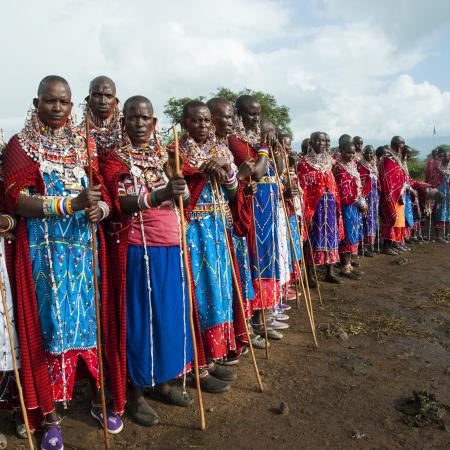
A través de casi 200 mujeres y contando, el IFAW está cambiando la cara de la conservación. Por primera vez, las mujeres de la comunidad maasai se sienten incluidas en los asuntos comunitarios relacionados con la conservación de la fauna salvaje, algo que en tiempos pasados estaba reservado a los hombres. La comunidad masai, y de hecho la mayoría de los entornos tradicionales de Kenia, son en gran medida patriarcales, y apenas se consulta a las mujeres ni se las implica en el liderazgo y la toma de decisiones. Sin embargo, el tiempo está cambiando poco a poco esta situación, ya que se ha hecho evidente que tienen mucho que ofrecer.
En la aldea llamada Kitirua, casi 200 mujeres se han autoorganizado para formar un grupo comunitario conocido como el grupo Enduata Kitirua - Enduata es "visión" en lengua maa; mientras que Kitirua es la aldea de la que proceden. El grupo se registró oficialmente a principios de 2018 y se ha convertido en una vía para que las mujeres se ganen la vida a través de la venta de abalorios. También han puesto en marcha un negocio para abastecer, con beneficios, a las bases de guardabosques de la comunidad con suministros mensuales. Utilizan los beneficios para educar a dos niñas de familias económicamente desfavorecidas. Según las encuestas, estas mujeres ven ahora la vida salvaje por su beneficio y no como una molestia, afirmando que la vida salvaje es una atracción turística y que saben que un elefante puede educar a 100 niños gracias a los ingresos del turismo. Los negocios de abalorios y suministros también han proporcionado ingresos para que las mujeres compren linternas de mano generadas por energía solar, que utilizan alrededor de las granjas no sólo para iluminar, sino también para mantener a los animales salvajes alejados durante la noche, lo que lleva a menos casos de depredación del ganado. Como la mayoría de las mujeres nunca fueron a la escuela, hay una necesidad urgente de que reciban educación sobre los nombres en inglés o swahili de los animales salvajes para que puedan comunicarlos eficazmente a los guardabosques que no hablan la lengua maa. Se está planeando colaborar con el Ministerio de Educación para traducir los nombres de la fauna del maa al inglés y al swahili.
